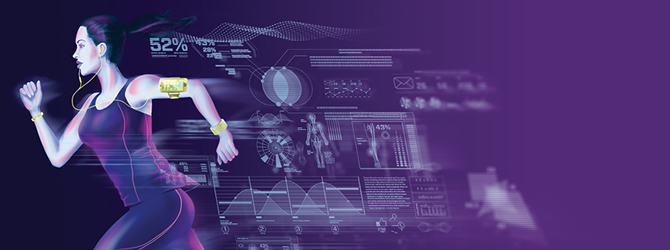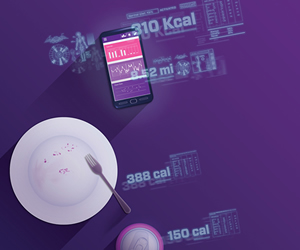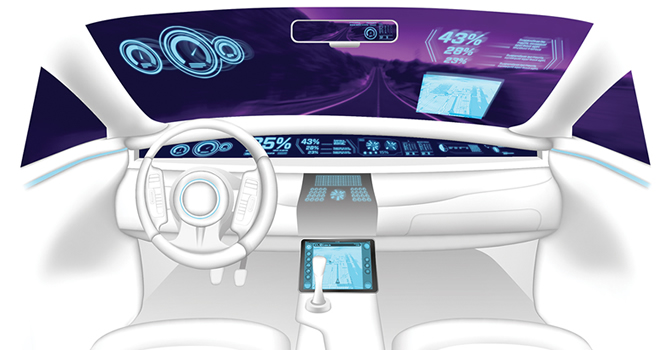
Data Driving
Your Life
How using auto-analytics can make you a better, faster, stronger person — inside and out
Rightnow, you — or the person you’re sitting next to — are likely monitoring at least two factors within the body. Your steps per minute, perhaps. Or your heart rate. Maybe your mood. The self-tracking possibilities are seemingly endless, and they are expanding every day: Exercise, sleep, calories, mood, alertness, productivity, heart health — nearly every facet of your life can be tracked with a device today.
According to a recent Nielsen report, one in six people use wearable tech devices, such as a smartwatch, workout shirt or fitness wristband. These tracking devices, or smart tools, have been gaining ground in the marketplace for the past several years. The Fitbit debuted as a prototype in 2008, and in 2009 it and a similar device, DirectLife, became available to the public. Other options quickly followed, and the idea of quantifying our lives took a modern hold, with the wearable tech industry valued at $5.1 billion in 2014, according to New York-based ABI Research.
The Evolution of Gamification
The idea of gathering data on ourselves is not new. “This has not come out of nowhere,” says Shane Greenstein, the Kellogg Chair in Information Technology and a professor of strategy. “It was not hard to imagine wearable products quite some time ago.”
For centuries, people have kept lists about their habits and reviewed them over time. A common reference point is Benjamin Franklin, who in 1726 started a personal virtues chart where he kept tally of how well he upheld his 13 virtues. Franklin would jot down a mark each time he failed at one virtue or another, to help him better himself over time.
“If I’m a marathon runner, and I’m serious about that performance, I’d like to go back and get almost a preview reel of future performance.”
Manash Goswami ’05, a former Motorola category director for wearable productsThe idea of replacing intuition and guesswork with facts and statistics, or “a quantified life,” is inherently appealing, says Manash Goswami ’05, a former Motorola category director for wearable products. But keeping up with a written list — whether it’s tracking virtues, calories, miles ran or anything else — requires a considerable amount of diligence and active attention, especially over a lengthy period of time. “You want to focus on the job at hand,” says Goswami. “Are things being measured while you are doing it?”
Then technology caught up. Smartphones and electronic sensors became commonplace. The process changed from being active (pen and paper) to passive (wearable auto-monitoring). And quickly, the idea of self-tracking became considerably more appealing. “So, if I’m a marathon runner, and I’m serious about that performance,” offers Goswami, “I’d like to go back and get almost a preview reel of future performance. A rearview mirror of what happened is very important for serious fitness enthusiasts as they try to improve.”
How to Game Your Life
People started buying and wearing these tracking devices. They were seeing their activity numbers each day, and learning about themselves in a tangible, statistical manner. After a period of time, a wearer might notice that they average 12,000 steps per weekday, for example.

This is intriguing — at least at first. But after a while, that insight becomes static information, especially if you’re not a marathon runner. You see it, you understand it, you’re busy with day-to-day tasks and you go on with your life. “Is the information going only to the wearer, or is it being monitored by an expert?” notes David Dranove, the Walter J. McNerney Professor of Health Industry Management. For typical wearable devices, Dranove warns, “It’s just not really going to make anybody healthier, except to the extent that it motivates them to work.”
Others shared Dranove’s sentiment, and it helped shift the industry focus from simply gathering the data — you took 12,000 steps today — to doing something with the data. This has come in the form of apps and other software that offer reminders and goals.
“Fitbit was fascinating because it tapped into this competitive nature in people,” says Greenstein. The ability to share your tracking data on social media adds another element, both competitive and motivational. And there are also websites dedicated to holding you accountable to your tracking goals. For example, Beeminder is an app that tracks your progress on anything from your weight to how many push-ups you do a day, and it charges you money when you go off track.
It’s like walking around with a personal trainer or a mentor, says Goswami.
How to Game Your Career
In the same mindset that these tools can help in people’s personal lives, they can also help in work lives. The idea is to take the sleep data, the activity information, the workout goals — all of it — and use the information to increase work productivity.
Tejash Unadkat ’08 is the director of product at BASIS Science, which created the Basis Peak smartwatch, a fitness and sleep tracker. Unadkat is responsible for taking the biometric data the watch generates and providing actionable meaning to it. For example, users can compare their heart rate data with their workouts to gauge intensity or determine how their sleep quality correlates with activity the day before. “We extract different insights from these biometric data points that our users are not aware of,” Unadkat says.
In addition, time management apps, such as ATracker, RescueTime, My Minutes and countless others, help employees reduce wasted minutes in their day and more clearly see their workload capacity. This means that with today’s time management software options, we can make more educated decisions on whether we can take on that next project or meeting.
Instead of managers monitoring employees’ output, auto-analytics puts the monitoring in the employees’ hands — and with it, a more precise power to shape their careers.
“When you begin to analyze data across a number of different biomarkers, you’re able to take that data and use it to manage someone’s health.”
Star Cunningham ’01, CEO of 4D HealthwareHow to Game Your Health
What started as a consumer trend has now expanded into the health care industry, with potential for exponential impact on not only our daily lives but also in the way health care is managed in the future.
As an example, “It’s very important for someone with diabetes to understand the trends in their diabetes,” says Star Cunningham ’01, CEO of 4D Healthware. “When you begin to analyze data across a number of different — what we call biomarkers — then you’re able to take that data and use it to manage someone’s health,” Cunningham says. It’s taking the static data discussed above and putting it in front of a physician who can monitor it and take action when needed.
4D Healthware is a software that links a patient’s wearable fitness device to an online platform that incorporates the patient’s personal health history. This gives a more complete picture for the patient and for the physician. There are also now implantable cardiac defibrillators with a cellular connection to your physician’s office. “When a pacemaker is monitored,” observes Dranove, “that info is shared with your cardiologist, who is immediately aware and can read your results.”
Products like Vitality GlowCaps remind you to take your pills each day, and The Lively Safety Watch tracks your daily steps, as well as sends you pill-taking reminders and lets you call for emergency assistance by pressing a single button on the watch. In addition, websites like PatientsLikeMe.com let people share their data and experiences with various conditions, such as depression and heart disease. People can use the data to chart their personal health, contribute to health research or compare treatments and symptoms.
As more and more people use wearable devices, we are gathering more data over longer periods of time. So, what is the next step?
The Future: For Better or Worse?
The movement is toward analyzing the data in an automated manner. Right now, users have most of that responsibility. You can log into your tracking app and view your mood or activity chart over the past month, and then analyze it yourself. You might notice your mood dips every day during rush hour, or every Wednesday during a certain weekly meeting. You can then think of ways to counteract the dip. But the shift is for programs to analyze for you and automate the tracking process even further.
“To me, the future is going to be made up of partnerships of man and machines,” says Brian Uzzi, the Richard L. Thomas Professor of Leadership and Organizational Change and faculty director of the Kellogg Architectures of Collaboration Initiative.
One app, still in development, is the Personal Analytics Companion, an open-source app that seeks to track everything from exercise to business meeting schedules to your infant’s bowel movements. It then takes the data a step further by showing trends and relationships in the data, and lets users chart data across different experiments. It’s about going past observation and into analyzing the data to make changes and improvements in your life.
It’s also about thinking bigger. The future of the industry will go beyond serving our individual needs, says Uzzi. From a business point of view, he says, it’s about being able to “aggregate information to come up with master plans for influencing mass behavior.”
Data access and usability, however, are still huge issues in the industry. “The challenge,” says Cunningham, “is that for each device, there is a different set of data and a different protocol, and there is nothing that’s analyzing that information across the board and making it actionable for consumers.”
4D Healthware and other companies have started to tackle this issue. One website, called DataDonors.org, let’s people upload their personal self-tracking data to contribute to a larger database that can then be used by researchers to improve health and potentially prevent illnesses.
But with this emphasis on sharing is the inherent concern of privacy. Not only do researchers want this data, but also marketers and insurance companies. Still, as we become increasingly accustomed to living in a public world, the downside becomes less concerning, at least to some. After all, the beauty of auto-analytics is that it removes the middleman. It gives us what we want, when we want it — which is, nearly always, now.


